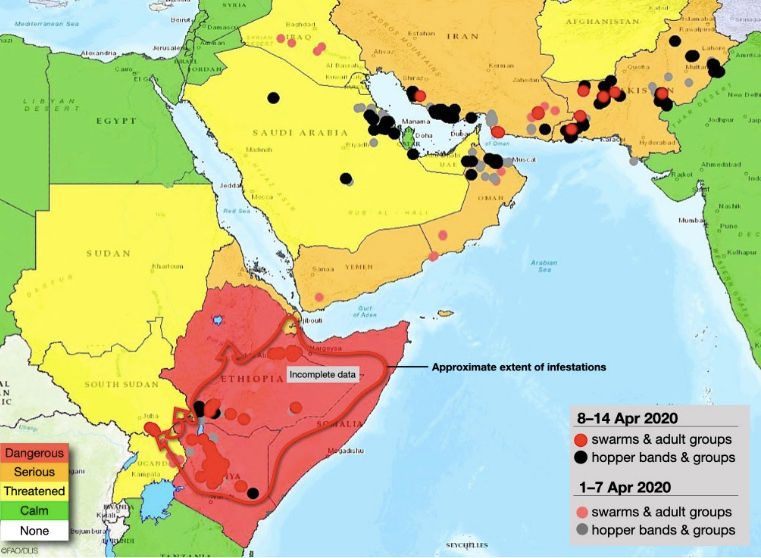South Sudan – Food security, famine and national potential
- Tip Toe

- Dec 27, 2020
- 3 min read
There is now a real and very present danger of famine in many parts of South Sudan. Large areas have been left fallow following years of conflict. Most of the crops that have been sown are now lost to recent flooding, and those remaining are threatened by locust swarms before harvest. There is a risk that existing small pockets of famine may expand; over 7m people are at risk. Aid Agencies are reporting difficulties accessing areas to make critical assessments and distribute essential food supplies across the country. If widespread famine is to be avoided (and / or managed effectively) then every assistance must be given by the government to allow international aid agencies access to plan and make preparations whilst ensuring their safety.
Food security and a thriving agriculture sector are fundamental to long term peace and development. South Sudan has rich soil and a favourable climate. Most of the crops are rain fed and flooding is a regular occurrence in lowland areas. Sorghum, maize, millet and rice are typical staple crops. For now agriculture in South Sudan largely remains at subsistence level with average field sizes of two acres per household. Crop yields are very low due to use of poor quality seeds, tools and agronomic practices. South Sudan, previously an exporter of agricultural products, now has to import about 50% of its cereal needs from Kenya and Uganda.
Livestock provides the main source of livelihood for a substantial portion of the population, with herds (mostly cattle) concentrated primarily in western parts of Upper Nile state, and in East Equatoria, Jonglei and Bahr El- Ghazal states. Livestock are raised by nomads and semi-nomads and are entirely dependent on access to grazing land and watering points. The increasing number of sedentary farmers is reducing the amount of grazing land available and is a source of internal conflict in the country. This community friction is worsened by the loss of cattle and grazing in recent flooding. The associated pastoralist fighting can be very violent and carries a risk of escalation into wider conflict for political gain. Disease runs unchecked through herds due to the lack of veterinary support. The very undeveloped livestock sector therefore presents a potential source of friction upon which wider conflict could erupt. The Fisheries sector is also similarly under developed.
The same poor internal communications that frustrates the distribution of Aid also presents barriers to growth of the agriculture sector. Access to markets is frustrated by poor infrastructure, the lack of paved roads, lack of product storage, processing and cold storage at key locations across the country including international airports. No reliable electricity and water supplies, lack of reliable freight services, low cost communications networks and skilled labour all present barriers to growth, mobility and market access.
The world’s newest internationally recognised country, South Sudan has been troubled since its inception in 2011 when it won independence from the Republic of Sudan. Political and tribal power struggles led to about eight years of civil war and drove the displacement of a large proportion of the population. Agreement between President Salva Kir, his deputy Riek Machar and the creation of a ‘Unification Government’ in early 2020, marked a potential turning point; the start of a somewhat frail peace and an opportunity to finally start building a nation.
South Sudan has been plagued by poor governance, corruption and failure to establish a professional, well disciplined, integrated national defence force. The business environment remains unattractive to international investors as its characterised by insecurity, a weak judicial system, poor regulatory environment and banking services with little or no access to foreign exchange. The international finance community (including the Chinese Government) are wearied by South Sudan’s persistent failure to meet its obligations and it is a country without material credit lines now reliant on international aid.
South Sudan depends on good relationships with Sudan and Kenya for access to gateway Ports to international trade markets via the Red Sea and the Indian Ocean; the country is also bordered by Ethiopia, Central African Republic, DRC and Uganda. Despite being land locked and all the problems described above, South Sudan has great potential if ethnic and community differences can be set aside and the recurring violence stopped to safeguard peace. This may be especially challenging with such a young population; approximately half the population (~12m) is under 18 yrs of age but South Sudan must wean itself off international aid and facilitate the growth required to stand on its own feet. In addition to agricultural opportunities, the country has a wide variety of natural resources upon which to build including petroleum, iron ore, copper, chromium ore, zinc, tungsten, mica, silver, gold, and hydropower.



Comments